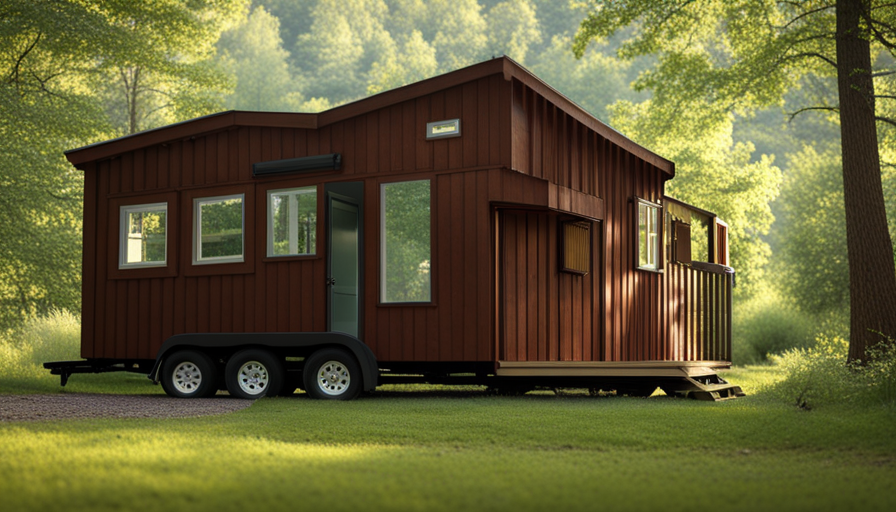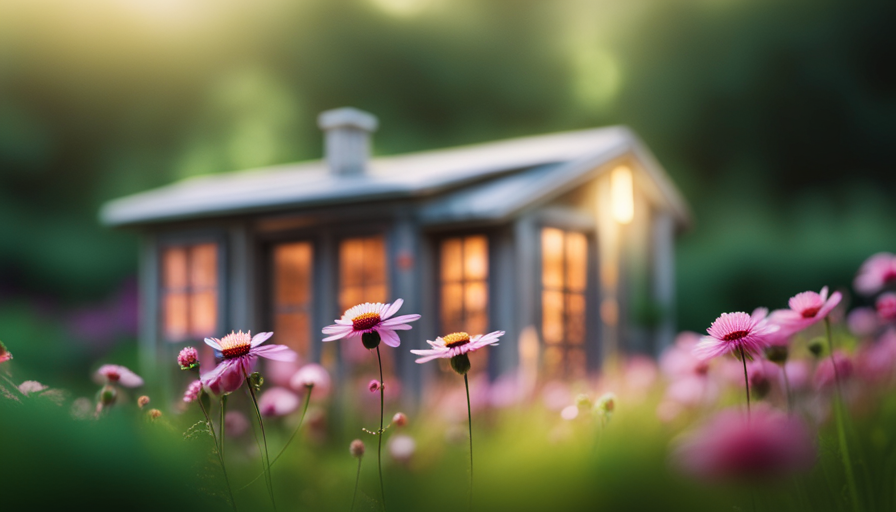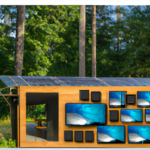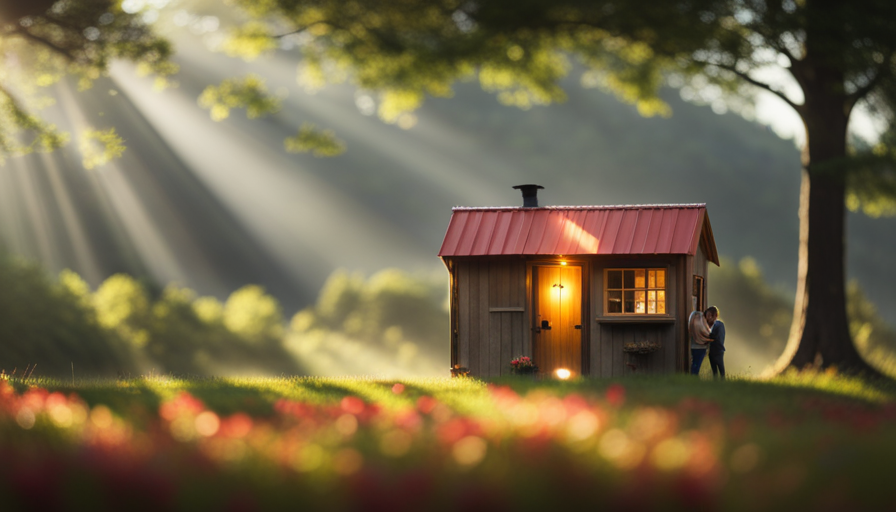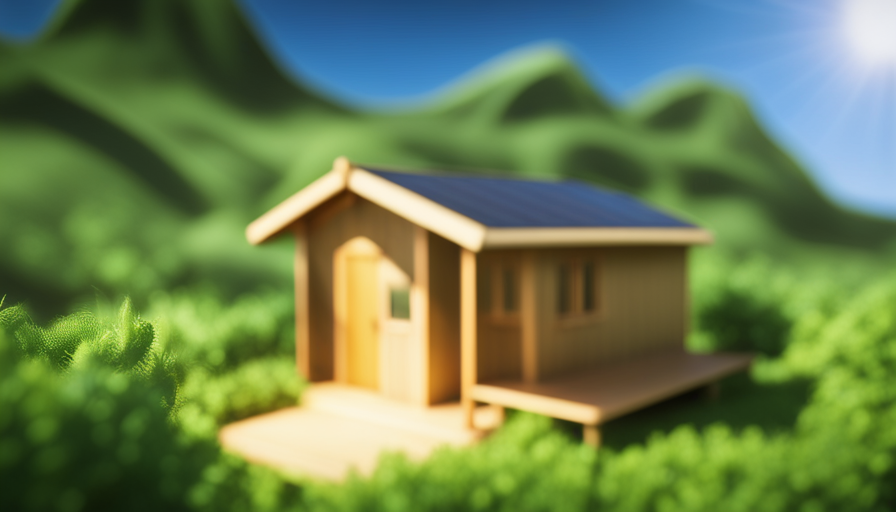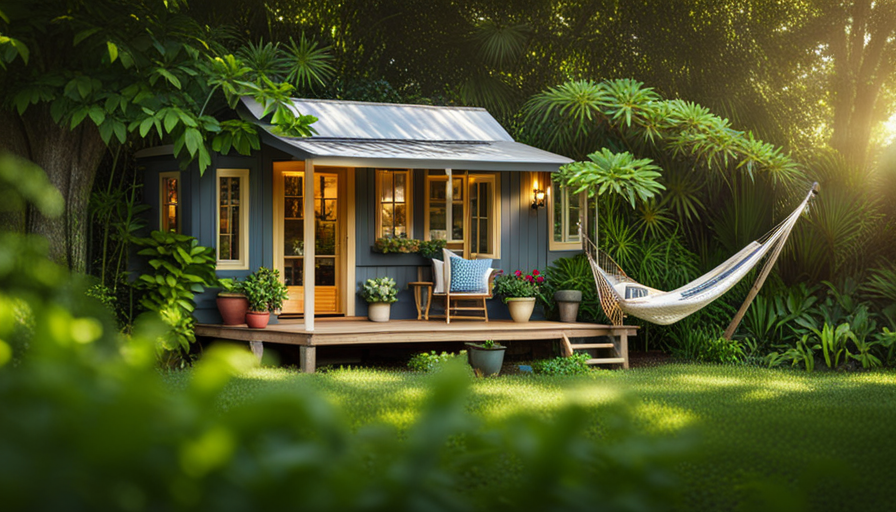Did you realize that the small house movement, captivating people all over the globe, has its origins stretching back several decades? Indeed, a new study reveals that the movement took root in the 1970s, emerging as an answer to rising worries about environmental sustainability and the escalating prices of owning a home.
As an avid researcher and enthusiast of the tiny house movement, I have delved deep into its origins and evolution. In this article, I will take you on a journey through time, exploring the early influences, the rise of small house builders, the impact of social media and television, as well as government regulations and zoning laws that have shaped this movement.
We will also delve into the innovative designs that have made tiny houses so unique and explore the challenges and criticisms they face.
So, join me as we uncover the history, analyze the evidence, and envision the future of the tiny house movement.
Key Takeaways
- The tiny house movement began in the 1970s as a response to concerns about environmental sustainability and the cost of homeownership.
- Early influences for the movement included Henry David Thoreau’s book ‘Walden’ and the Arts and Crafts movement.
- The first tiny house builders emerged in the late 1990s, driven by the principles of simplicity, sustainability, and freedom.
- Social media and television played a significant role in popularizing the movement, showcasing tiny house lifestyles and inspiring others.
Early Influences on the Tiny House Movement
You might not realize it, but the early influences on the tiny house movement were quietly shaping the way we think about homeownership and sustainability. In the early days, there were a few pioneers who paved the way for the movement.
One such pioneer was Henry David Thoreau, whose book ‘Walden’ emphasized the importance of simplicity and living close to nature. Thoreau’s ideas resonated with many people and sparked a desire for a simpler, more sustainable lifestyle.
Another architectural influence on the tiny house movement was the work of the Arts and Crafts movement in the late 19th and early 20th centuries. This movement, led by figures like William Morris and Gustav Stickley, emphasized craftsmanship, quality materials, and a rejection of mass production. These ideas aligned with the principles of the tiny house movement, which emphasizes small, well-crafted homes that are built to last.
The early pioneers and architectural influences laid the foundation for what would become the tiny house movement. But it was the first tiny house builders who truly brought these ideas to life. They took inspiration from the past while incorporating modern design and technology. Through their creativity and innovation, they showed that living in a tiny house could be both practical and beautiful.
Transitioning into the subsequent section about the first tiny house builders, these early pioneers set the stage for a movement that continues to grow and evolve today.
The First Tiny House Builders
The first builders of these compact homes emerged in the late 1990s, around the same time when the minimalist lifestyle gained popularity. These early pioneers of the tiny house movement were driven by a desire for simplicity, sustainability, and freedom from the constraints of conventional housing. They saw tiny houses as a way to live more intentionally, with a smaller carbon footprint and less financial burden.
The first tiny house communities started to form during this time, as like-minded individuals came together to share resources, ideas, and support. These communities provided an opportunity for tiny house enthusiasts to connect and learn from each other, fostering a sense of camaraderie and a shared vision for a more sustainable way of living.
In terms of design trends, the early tiny house builders favored simplicity and functionality. They embraced the use of multipurpose furniture, clever storage solutions, and efficient use of space. These design choices allowed them to maximize every square inch of their tiny homes, creating a comfortable and livable environment despite the limited space.
As the tiny house movement gained momentum, these early builders laid the foundation for what would become a global phenomenon. Their innovative ideas and dedication to a simpler way of life paved the way for future generations of tiny house enthusiasts. With the rise of the small house movement, the tiny house community continued to grow and evolve, inspiring more people to rethink their housing choices and embrace a minimalist lifestyle.
The Rise of the Small House Movement
With the emergence of the minimalist lifestyle in the late 1990s, a new way of living began to take root – the small house movement. People started to realize the benefits of living with less and downsizing their living spaces. This led to the rise of tiny house communities, where like-minded individuals came together to support and inspire each other in their journey towards a simpler life.
One of the main reasons behind the popularity of tiny house communities is the psychological benefits of living in a small space. Research has shown that living in a smaller house can lead to reduced stress levels and increased feelings of contentment. The limited space forces individuals to prioritize and declutter their lives, leading to a more organized and peaceful living environment. Additionally, the close-knit nature of these communities fosters a sense of belonging and support, which further enhances the overall well-being of the residents.
Moreover, the small house movement has gained momentum through the influence of social media and television. Platforms like Instagram and YouTube have allowed individuals to showcase their small house lifestyles, inspiring others to follow suit. Television shows like ‘Tiny House, Big Living’ have also contributed to the rise of the movement by showcasing the practicality and creativity behind living in a small space.
The impact of social media and television on the small house movement will be explored further in the subsequent section.
The Impact of Social Media and Television
Has social media and television fueled the popularity of the small house movement? It is undeniable that these platforms have had a significant impact on changing perceptions and cultural influence surrounding tiny houses.
With the rise of social media platforms like Instagram and Pinterest, people have been exposed to stunning images and stories of individuals living in tiny houses. These platforms have allowed tiny house enthusiasts to showcase their unique lifestyles, inspiring others to consider the benefits of minimalist living.
Television shows such as ‘Tiny House Nation’ and ‘Tiny House Hunters’ have also played a crucial role in popularizing the movement. These shows not only highlight the creative design and functionality of tiny houses but also shed light on the financial and environmental advantages they offer. By showcasing real people living happily in small spaces, these shows have dispelled misconceptions and sparked curiosity among viewers.
The impact of social media and television on the tiny house movement cannot be underestimated. They have provided a platform for tiny house enthusiasts to connect, share ideas, and gain inspiration. Moreover, by showcasing the benefits and beauty of tiny houses, these platforms have helped change public perception and encourage individuals to consider alternative housing options.
Transitioning to the subsequent section about government regulations and zoning laws, it is important to understand the challenges that the tiny house movement faces.
Government Regulations and Zoning Laws
Government regulations and zoning laws present significant obstacles for those interested in joining the small house movement. While the tiny house movement has gained popularity in recent years, with an increasing number of people opting for minimalistic living, navigating the legal aspects of building and living in a tiny house can be challenging.
Government regulations vary from state to state and even within different municipalities, making it difficult to establish a standardized set of rules for tiny house construction and placement.
One of the biggest challenges faced by tiny house enthusiasts is zoning laws. Many areas have strict regulations regarding minimum square footage requirements for dwellings, which can exclude tiny houses from being classified as legal residences. Additionally, zoning laws often dictate where and how tiny houses can be placed, limiting their potential locations and making it difficult to find suitable land for these homes.
Despite these obstacles, the tiny house movement continues to grow, with advocates pushing for changes in government regulations and zoning laws. Some municipalities have started to recognize the benefits of tiny houses, such as their affordability and environmental friendliness, and have begun to amend their zoning laws to accommodate them.
While government regulations and zoning laws currently present challenges for those interested in joining the small house movement, there is a growing recognition of the potential benefits of tiny houses. This has led to some positive changes in regulations and zoning laws, making tiny houses a viable solution for affordable housing in certain areas.
Tiny Houses as a Solution to Affordable Housing
As I mentioned earlier, government regulations and zoning laws have presented significant challenges for the tiny house movement. However, despite these obstacles, tiny houses have emerged as a potential solution to the affordable housing crisis that many communities face.
Tiny houses offer an alternative housing option that is both affordable and environmentally sustainable. With their small size, tiny houses require fewer building materials and use less energy for heating and cooling. This makes them a more eco-friendly choice compared to traditional larger homes. Additionally, tiny houses promote minimalistic living, encouraging individuals to downsize their possessions and live a simpler, more sustainable lifestyle.
The affordability and sustainability of tiny houses make them an attractive option for individuals and families looking for affordable housing solutions. For those struggling to afford a conventional home, tiny houses offer a more accessible and affordable alternative. Moreover, the small size of these homes allows for greater flexibility in terms of location, as they can be built on smaller plots of land or even on wheels.
Tiny houses have gained popularity as a potential solution to the affordable housing crisis. Their environmental sustainability and minimalistic living appeal make them an attractive option for individuals and families seeking affordable housing. Moving forward, it’s important to explore innovative designs and technologies that can further enhance the functionality and livability of tiny houses.
Tiny House Design and Innovation
When it comes to tiny house design and innovation, there are two key points that stand out: creative solutions for maximizing space and functionality, and the use of sustainable materials and renewable energy sources.
These aspects are crucial in making tiny houses not only livable, but also efficient and environmentally friendly. By thinking outside the box and finding clever ways to utilize every inch of space, designers can create tiny homes that feel surprisingly roomy and functional.
Additionally, incorporating sustainable materials and renewable energy sources into the construction and operation of tiny houses helps reduce their environmental impact, making them a more sustainable housing option for the future.
Creative solutions for maximizing space and functionality
One of the most ingenious ways to make the most out of limited space in tiny houses is by implementing clever storage solutions. By utilizing every nook and cranny, it’s possible to create a functional and organized living space. Here are three sub-lists showcasing creative solutions for maximizing space and functionality:
-
Multi-functional furniture: Investing in furniture that serves multiple purposes is key to maximizing space in a tiny house. For example, a sofa that can transform into a bed or a coffee table with hidden storage compartments.
-
Vertical storage: Utilizing vertical wall space with shelves, hooks, and hanging organizers is an effective way to store items and keep them easily accessible without taking up valuable floor space.
-
Built-in storage: Custom-built cabinets, drawers, and closets can be tailored to fit specific needs and maximize storage capacity in small living spaces.
By incorporating these small living solutions, tiny house dwellers can create a clutter-free and efficient living environment. Transitioning into the subsequent section about the use of sustainable materials and renewable energy sources, it’s important to consider the environmental impact of these design choices.
The use of sustainable materials and renewable energy sources
Utilizing sustainable materials and renewable energy sources is essential for creating an eco-friendly and energy-efficient living environment in tiny houses. Sustainable architecture and eco-friendly construction practices play a crucial role in achieving these goals.
When constructing a tiny house, it’s important to consider the environmental impact of the materials used. Opting for materials like reclaimed wood, bamboo, or recycled metal not only reduces waste but also promotes a more sustainable lifestyle.
Additionally, incorporating renewable energy sources such as solar panels or wind turbines can provide clean and efficient power for the house. These sustainable choices not only minimize the carbon footprint of tiny houses but also contribute to long-term energy savings.
By embracing sustainable practices in construction and energy use, tiny houses can serve as models for environmentally conscious living. Transitioning to the subsequent section about ‘the tiny house movement goes global’, we can explore how this eco-friendly mindset is spreading worldwide.
The Tiny House Movement Goes Global
As the tiny house movement continues to gain momentum, it’s rapidly spreading its influence across the globe.
The global expansion of this movement is evident in the increasing number of tiny house communities and enthusiasts in different countries. Each country brings its own unique cultural influences to the movement, resulting in a diverse range of tiny house designs and lifestyles.
In Europe, for example, the tiny house movement has gained popularity as a response to the housing crisis and the desire for a more sustainable lifestyle. Many European countries have stringent building regulations, which has led to the development of innovative and compact designs that adhere to these regulations. Scandinavian countries, known for their minimalist and functional design, have embraced the tiny house movement with gusto.
In Asia, where space is often at a premium, the tiny house movement offers a solution to overcrowded cities. Japan, in particular, has a long history of small living spaces and has embraced the concept of minimalism. Tiny houses in Japan often incorporate traditional architectural elements, such as sliding doors and tatami mats, blending modern design with cultural heritage.
The global expansion of the tiny house movement has brought together people from different backgrounds and cultures, all united by a shared desire for a simpler, more sustainable way of living. However, this movement isn’t without its challenges and criticisms. [Transition sentence into the next section about challenges and criticisms of the tiny house movement].
Challenges and Criticisms of the Tiny House Movement
The challenges and criticisms facing the global expansion of the tiny house movement are diverse and thought-provoking. While the movement has gained popularity worldwide, it has also faced its fair share of obstacles.
Here are some of the challenges and criticisms that have been raised:
-
Zoning and building codes: One of the main challenges for tiny house enthusiasts is navigating the complex zoning and building codes that vary from place to place. Many cities and towns have minimum size requirements for dwellings, making it difficult for tiny houses to be legally established.
-
Lack of infrastructure: Another challenge is the lack of infrastructure to support tiny houses. Many areas do not have designated parking or utilities for these homes, making it difficult for people to live in them full-time.
-
Social stigma: Critics argue that tiny houses perpetuate a ‘poor’ or ‘homeless’ image. They argue that people should aspire to larger, more traditional homes and that tiny houses are not a viable long-term solution.
-
Limited space: Some critics argue that the limited space in tiny houses can be impractical and uncomfortable for everyday living. They believe that people should have more space to move around and store their belongings.
Despite these challenges and criticisms, the tiny house movement continues to grow and evolve. As more people embrace minimalistic living and seek alternatives to traditional housing, the future of the tiny house movement looks promising.
The Future of the Tiny House Movement
Despite the challenges and criticisms, the future of the tiny house movement looks promising, with an estimated 63% increase in the number of tiny house dwellers projected by 2025.
As people become more aware of the environmental impact of traditional homes, they’re turning to tiny houses as a sustainable alternative. The future trends of the movement indicate a growing interest in off-grid living, with advancements in renewable energy and water conservation technologies making it easier for tiny house dwellers to live independently and sustainably.
One of the main reasons why the future of the tiny house movement is bright is its positive environmental impact. Tiny houses require significantly fewer resources to build and maintain compared to traditional homes. They have a smaller carbon footprint and consume less energy. Additionally, many tiny house dwellers embrace a minimalist lifestyle, which further reduces their overall consumption and waste generation.
Another future trend of the tiny house movement is the increasing popularity of off-grid living. With advancements in solar power, wind turbines, and water harvesting systems, more and more tiny house dwellers are able to live completely self-sufficiently, without relying on traditional utilities. This not only reduces their environmental impact but also gives them a sense of independence and freedom.
The future of the tiny house movement looks promising, with a projected increase in the number of tiny house dwellers and a focus on sustainable living. As people become more conscious of their environmental impact and seek alternatives to the traditional housing model, tiny houses offer a viable solution. With future trends pointing towards off-grid living and advancements in renewable technologies, the movement is set to thrive in the years to come.
Frequently Asked Questions
How much does it cost to build a tiny house?
Building a tiny house can cost anywhere from $10,000 to $100,000, depending on factors such as size, materials, and location. DIY construction is generally cheaper, with costs ranging from $10,000 to $30,000, while professional construction can cost upwards of $50,000.
What are the different types of tiny houses available?
There are various types of tiny houses available, each with unique designs and storage solutions. From tiny homes on wheels to shipping container houses, the tiny house movement has brought forth innovative and creative living options.
Are tiny houses legally allowed in all areas?
Tiny house zoning regulations vary by location, and not all areas allow tiny houses. Challenges faced by tiny house owners include finding suitable locations that meet zoning requirements and obtaining necessary permits.
How do tiny house owners deal with utilities like water and electricity?
In dealing with utilities like water and electricity, tiny house owners often employ water conservation techniques to minimize usage. Some choose to live off the grid, relying on alternative sources such as solar panels or rainwater harvesting.
Can I finance a tiny house like a traditional home?
Yes, you can finance a tiny house like a traditional home. There are financing options available, including loans specifically designed for tiny homes. However, loan requirements may vary depending on the lender.
Conclusion
In conclusion, the tiny house movement has come a long way since its humble beginnings. From the early influences and the first builders, to the rise of social media and television, this movement has gained momentum and spread globally. Despite challenges and criticisms, the future looks bright for tiny houses.
As an advocate for this lifestyle, I firmly believe that the innovative design and the freedom it provides will continue to attract individuals looking to simplify their lives and break free from the constraints of traditional housing. So let’s embrace the ‘small is beautiful’ mantra and join this revolution!
Hi, I’m Emma. I’m the Editor in Chief of Tiny House 43, a blog all about tiny houses. While tree houses are often associated with childhood, they can be the perfect adult retreat. They offer a cozy space to relax and unwind, surrounded by nature. And since they’re typically built on stilts or raised platforms, they offer stunning views that traditional homes simply can’t match. If you’re looking for a unique and romantic getaway, a tree house tiny house might just be the perfect option.
